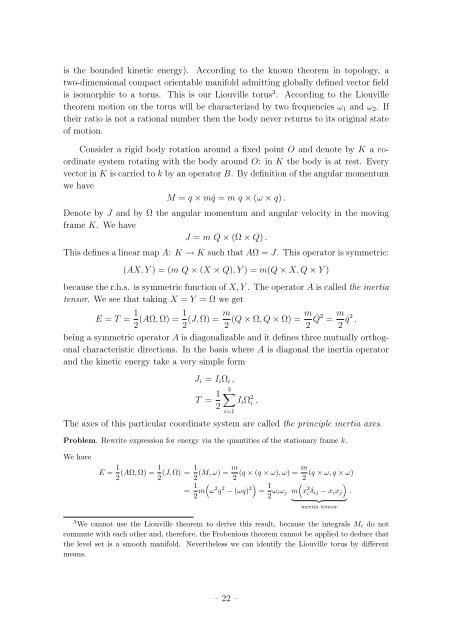Student Seminar: Classical and Quantum Integrable Systems
Student Seminar: Classical and Quantum Integrable Systems
Student Seminar: Classical and Quantum Integrable Systems
Create successful ePaper yourself
Turn your PDF publications into a flip-book with our unique Google optimized e-Paper software.
is the bounded kinetic energy). According to the known theorem in topology, a<br />
two-dimensional compact orientable manifold admitting globally defined vector field<br />
is isomorphic to a torus. This is our Liouville torus 3 . According to the Liouville<br />
theorem motion on the torus will be characterized by two frequencies ω 1 <strong>and</strong> ω 2 . If<br />
their ratio is not a rational number then the body never returns to its original state<br />
of motion.<br />
Consider a rigid body rotation around a fixed point O <strong>and</strong> denote by K a coordinate<br />
system rotating with the body around O: in K the body is at rest. Every<br />
vector in K is carried to k by an operator B. By definition of the angular momentum<br />
we have<br />
M = q × m ˙q = m q × (ω × q) .<br />
Denote by J <strong>and</strong> by Ω the angular momentum <strong>and</strong> angular velocity in the moving<br />
frame K. We have<br />
J = m Q × (Ω × Q) .<br />
This defines a linear map A: K → K such that AΩ = J. This operator is symmetric:<br />
(AX, Y ) = (m Q × (X × Q), Y ) = m(Q × X, Q × Y )<br />
because the r.h.s. is symmetric function of X, Y . The operator A is called the inertia<br />
tensor. We see that taking X = Y = Ω we get<br />
E = T = 1 2 (AΩ, Ω) = 1 2 (J, Ω) = m 2 (Q × Ω, Q × Ω) = m 2 ˙Q 2 = m 2 ˙q2 .<br />
being a symmetric operator A is diagonalizable <strong>and</strong> it defines three mutually orthogonal<br />
characteristic directions. In the basis where A is diagonal the inertia operator<br />
<strong>and</strong> the kinetic energy take a very simple form<br />
J i = I i Ω i ,<br />
T = 1 3∑<br />
I i Ω 2 i .<br />
2<br />
The axes of this particular coordinate system are called the principle inertia axes.<br />
Problem. Rewrite expression for energy via the quantities of the stationary frame k.<br />
We have<br />
i=1<br />
E = 1 2 (AΩ, Ω) = 1 2 (J, Ω) = 1 2 (M, ω) = m 2 (q × (q × ω), ω) = m (q × ω, q × ω)<br />
2<br />
= 1 (ω<br />
2 m 2 q 2 − (ωq) 2) = 1 )<br />
2 ω iω j m<br />
(x 2 i δ ij − x i x j .<br />
} {{ }<br />
inertia tensor<br />
3 We cannot use the Liouville theorem to derive this result, because the integrals M i do not<br />
commute with each other <strong>and</strong>, therefore, the Frobenious theorem cannot be applied to deduce that<br />
the level set is a smooth manifold. Nevertheless we can identify the Liouville torus by different<br />
means.<br />
– 22 –

















